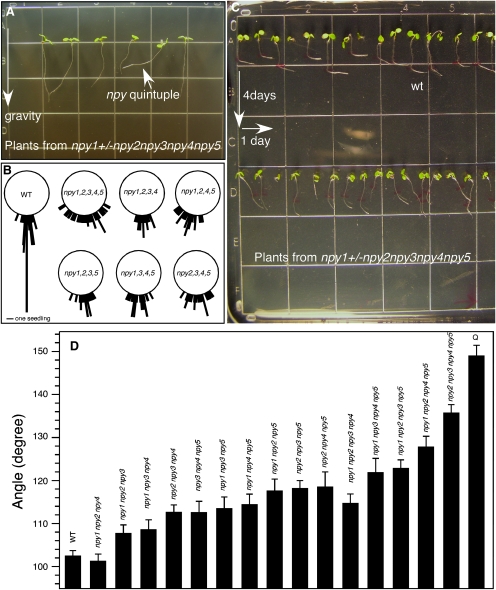Figure 2.
NPY Genes Contribute to Root Gravitropism.
(A) Seeds from a plant of npy1+/– npy2 npy3 npy4 npy5 were germinated and grown vertically for 7 d. The npy quintuple mutants (arrow head) showed defects in gravitropism. The direction of gravity is also marked with an arrow.
(B) Directions of root growth of wild-type and npy mutants. Plants were grown vertically for 4 d. The angle between the gravity vector and root were measured and are shown here. The bar refers to one seedling. If two seedlings have the same angle, the line at that angle is twice of the length of the bar. The total number of seedlings analyzed for each genotype were: 49 for WT, 45 for npy1, 2, 3, 4, 5 quintuple, 24 for npy1, 2, 3, 4 quadruple, 27 for npy1, 2, 4, 5 quadruple, 27 for npy1, 2, 3, 5 quadruple, 32 for npy1, 3, 4, 5 quadruple, and 28 for npy2, 3, 4, 5.
(C) Responses to a directional change of gravity. Plants were grown vertically for 4 d and then the plates were turned 90° for 1 d. The top row is wt and bottom row is plants from npy1+/– npy2 npy3 npy4 npy5. Note: wild-type roots bend about 90° while the npy mutants do not bend much.
(D) Quantitative analysis of gravitropism in npy mutant combinations. Plants were grown vertically for 4 d and the plates were turned 90° for 1 d. The angle of root bending was measured. The angle for perfect gravitropism is 90° and the angle for non-gravitropic growth is 180°. Q refers to the npy1 npy2 npy3 npy4 npy5 quintuple mutants. At least 20 seedlings were analyzed for each genotype shown in Figure 2D.

